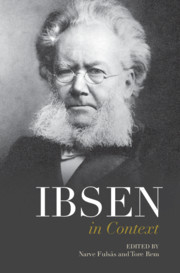Book contents
- Ibsen in Context
- Ibsen in Context
- Copyright page
- Contents
- Figures
- Contributors
- Preface
- Notes on the text
- Chronology
- Part I Life and Career
- Part II Culture and Society
- Chapter 4 Genres
- Chapter 5 Realism
- Chapter 6 Theatre
- Chapter 7 Visual Arts
- Chapter 8 Music
- Chapter 9 Philosophy
- Chapter 10 Science
- Chapter 11 Feminism
- Chapter 12 Capitalism
- Part III Scandinavian Reception
- Part IV Internationalization
- Part V Afterlives
- Further Reading
- Index
Chapter 10 - Science
from Part II - Culture and Society
Published online by Cambridge University Press: 23 April 2021
- Ibsen in Context
- Ibsen in Context
- Copyright page
- Contents
- Figures
- Contributors
- Preface
- Notes on the text
- Chronology
- Part I Life and Career
- Part II Culture and Society
- Chapter 4 Genres
- Chapter 5 Realism
- Chapter 6 Theatre
- Chapter 7 Visual Arts
- Chapter 8 Music
- Chapter 9 Philosophy
- Chapter 10 Science
- Chapter 11 Feminism
- Chapter 12 Capitalism
- Part III Scandinavian Reception
- Part IV Internationalization
- Part V Afterlives
- Further Reading
- Index
Summary
Ibsen engaged with many of the dominant scientific ideas of his time, especially those in the natural sciences, such as evolution and heredity. This chapter explores such scientific contexts and shows how and why Ibsen oscillated between respecting science, medicine and technology’s role in humanity’s progress and disparaging their destructive capabilities. The discussion also points out how science underpins some of Ibsen’s revolutionary innovations in theatrical form and content: his explorations of Zola’s naturalism, his dramatization of Darwin’s ideas, his foregrounding of the family unit as the subject of drama, his depiction of the constant tension between the twin forces of heredity and environment, and his radical scenographic vision of nature and landscape.
- Type
- Chapter
- Information
- Ibsen in Context , pp. 82 - 90Publisher: Cambridge University PressPrint publication year: 2021

